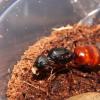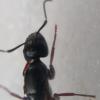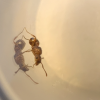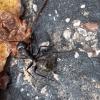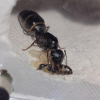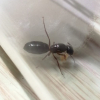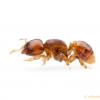- Formiculture.com
- Forums
- Gallery
- Members
- Member Map
- Chat

Cheeto's Pheidole rhea (Updated 4/21)
Started By
CheetoLord02
, Jul 21 2021 1:38 PM
94 replies to this topic
#41
 Offline
-
Posted August 25 2021 - 7:29 PM
Offline
-
Posted August 25 2021 - 7:29 PM
I totally understand your pain! I'm just dying for my Ph. pilifera to get their first major!!!
- Antkeeper014, Antkeeper01 and ANTS_KL like this
My Main Journal | My Neivamyrmex Journal | My Ant Adoption | My YouTube
Join the TennesseeAnts Discord Server! https://discord.gg/JbKwPgs
#42
 Offline
-
Posted September 1 2021 - 6:15 PM
Offline
-
Posted September 1 2021 - 6:15 PM

POPULAR
MAJOR LARVA MAJOR LARVA MAJOR LARVA
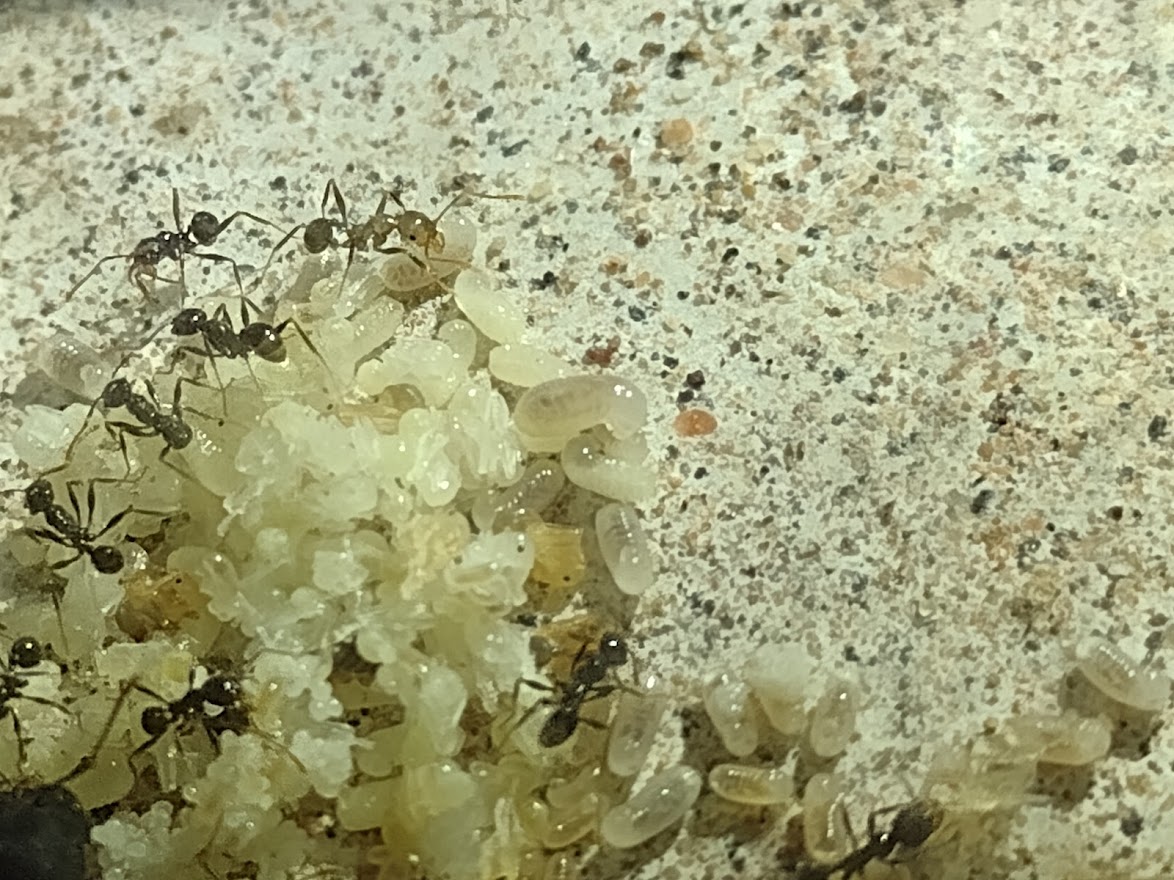
Honestly, it's unusual being able to differentiate major larvae at such a small size. With most Pheidole you only really notice a difference in the latest stages of development, but these majors are just so large compared to the minors that I guess it's easy to tell when they're still developing. I also have noticed this in P. obtusospinosa, but probably not even close to this extent. I'd imagine, or at least hope, that this larva will get MUCH larger before pupating.
Speaking of brood in general, they have a TON. So much brood, yet still not enough. Need more rhea.
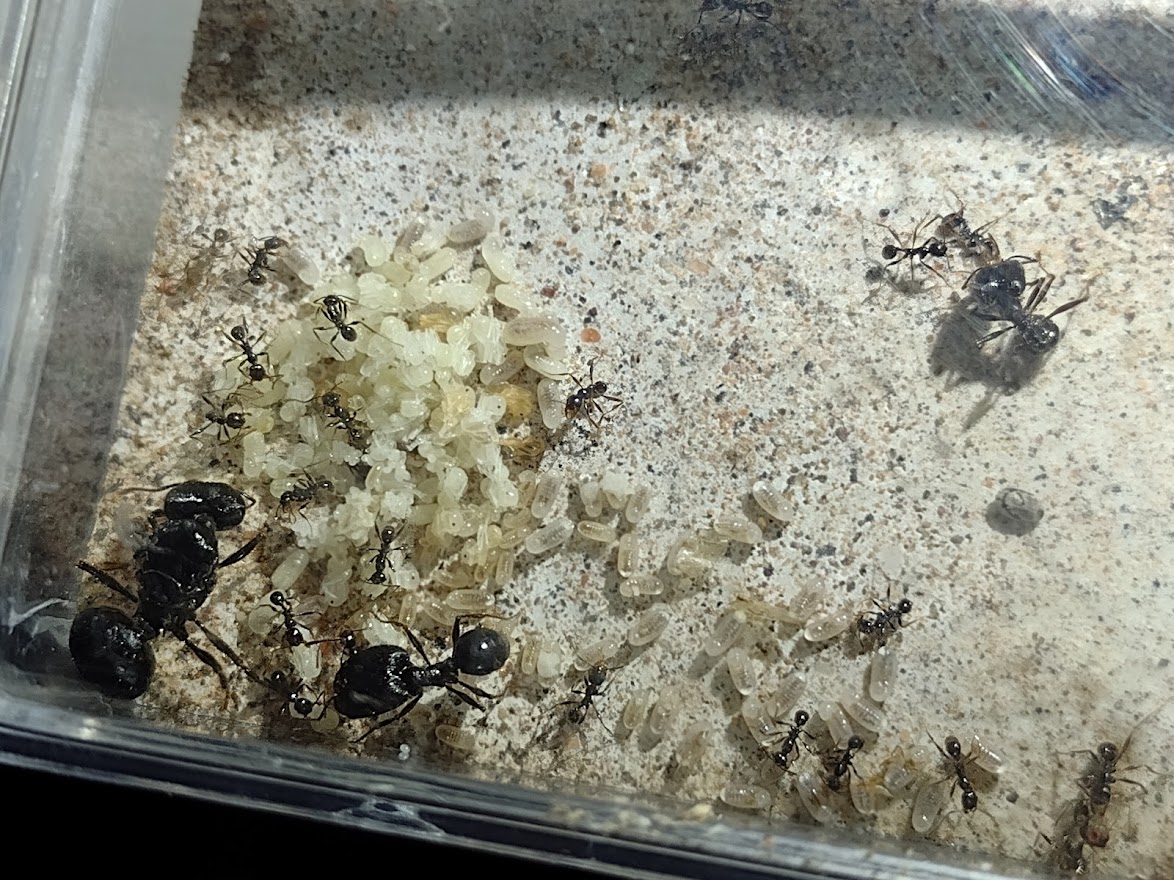
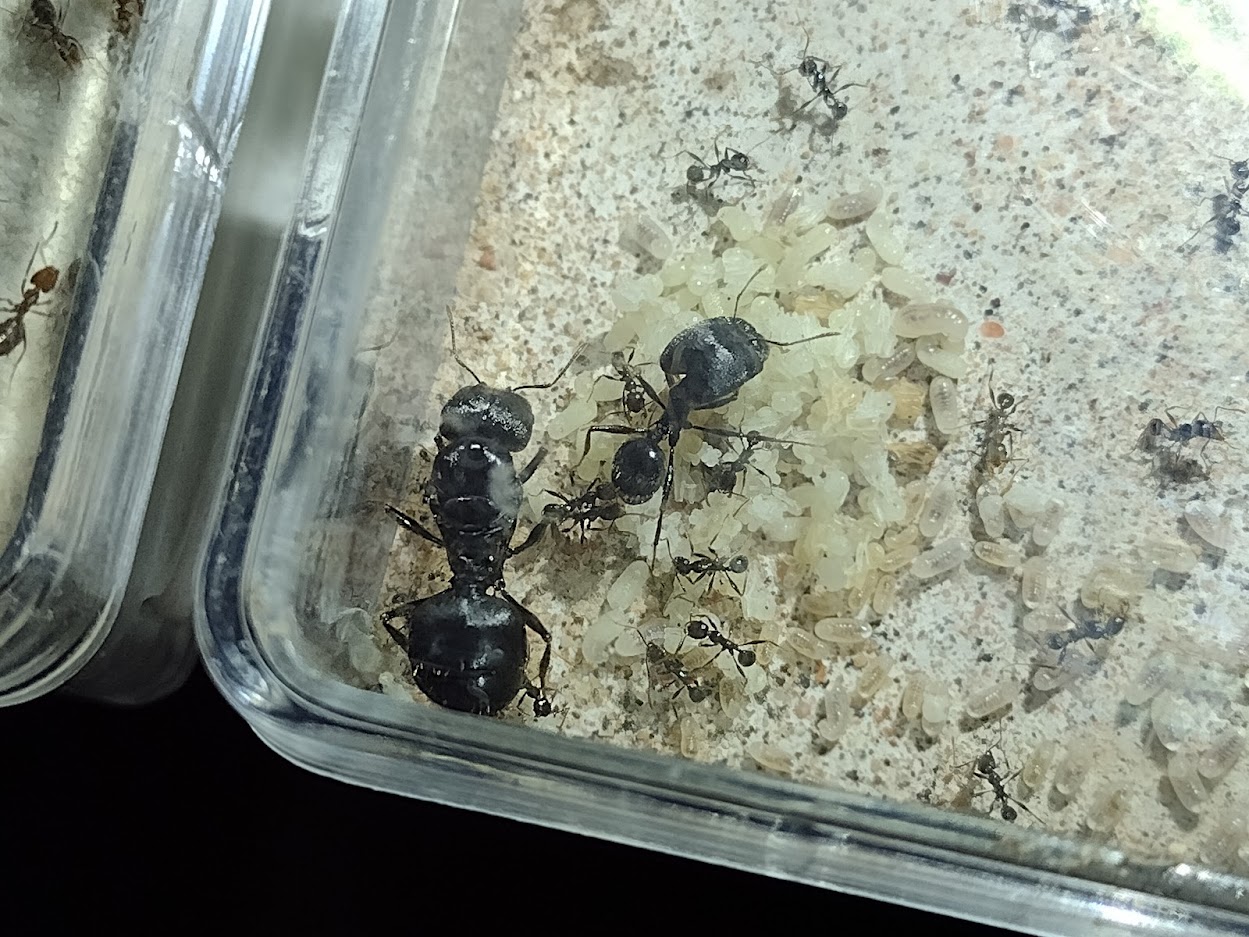
- AnthonyP163, SoySauce, Karma and 11 others like this
I like leafcutter ants. Watch The Ultimate Guide to Fungus Growing Ants:
https://youtu.be/VBH...4GkxujxMETFPt8U
This video took like over 100 hours of work, you should for sure watch it.
#43
 Offline
-
Posted September 1 2021 - 6:16 PM
Offline
-
Posted September 1 2021 - 6:16 PM
Just realized. This thread was made on my birthday haha.
- Antkeeper01, Moheab997 and Chickalo like this
#44
 Offline
-
Posted September 1 2021 - 6:40 PM
Offline
-
Posted September 1 2021 - 6:40 PM
Awesome! When are you going to update your collective Pheidole journal?
- Antkeeper01 likes this
My Main Journal | My Neivamyrmex Journal | My Ant Adoption | My YouTube
Join the TennesseeAnts Discord Server! https://discord.gg/JbKwPgs
#45
 Offline
-
Posted September 7 2021 - 5:35 PM
Offline
-
Posted September 7 2021 - 5:35 PM

POPULAR
More major larvae, and the original one at least seems to be pupating. It is now opaque, however it's also completely buried in the brood pile and also, there is a decent chance it's still developing. I've noticed with Atta and Pheidole obtusospinosa that the largest larvae seem to turn opaque before they finish developing. Either way, I'll soon find out if it's just a small major or if it's really still developing. I'll likely also see something similar in the new major larvae as they continue to develop.
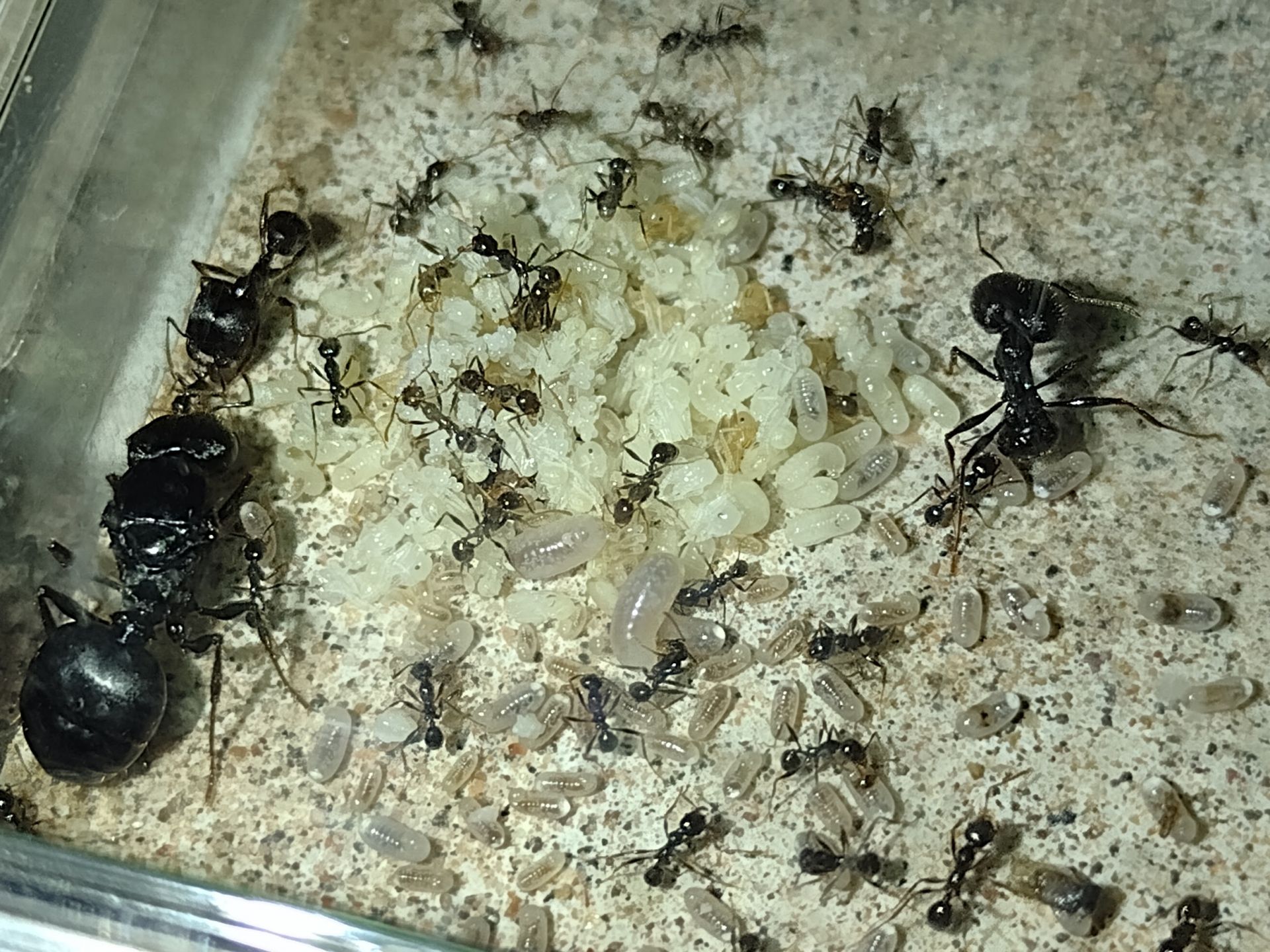
The colony in general is also starting to become a lot of fun. The smaller major routinely goes out and helps tear up crickets to bring into the nest, and they're overall being much more active in their foraging. They're now at 45 or so workers and more are always on the way.
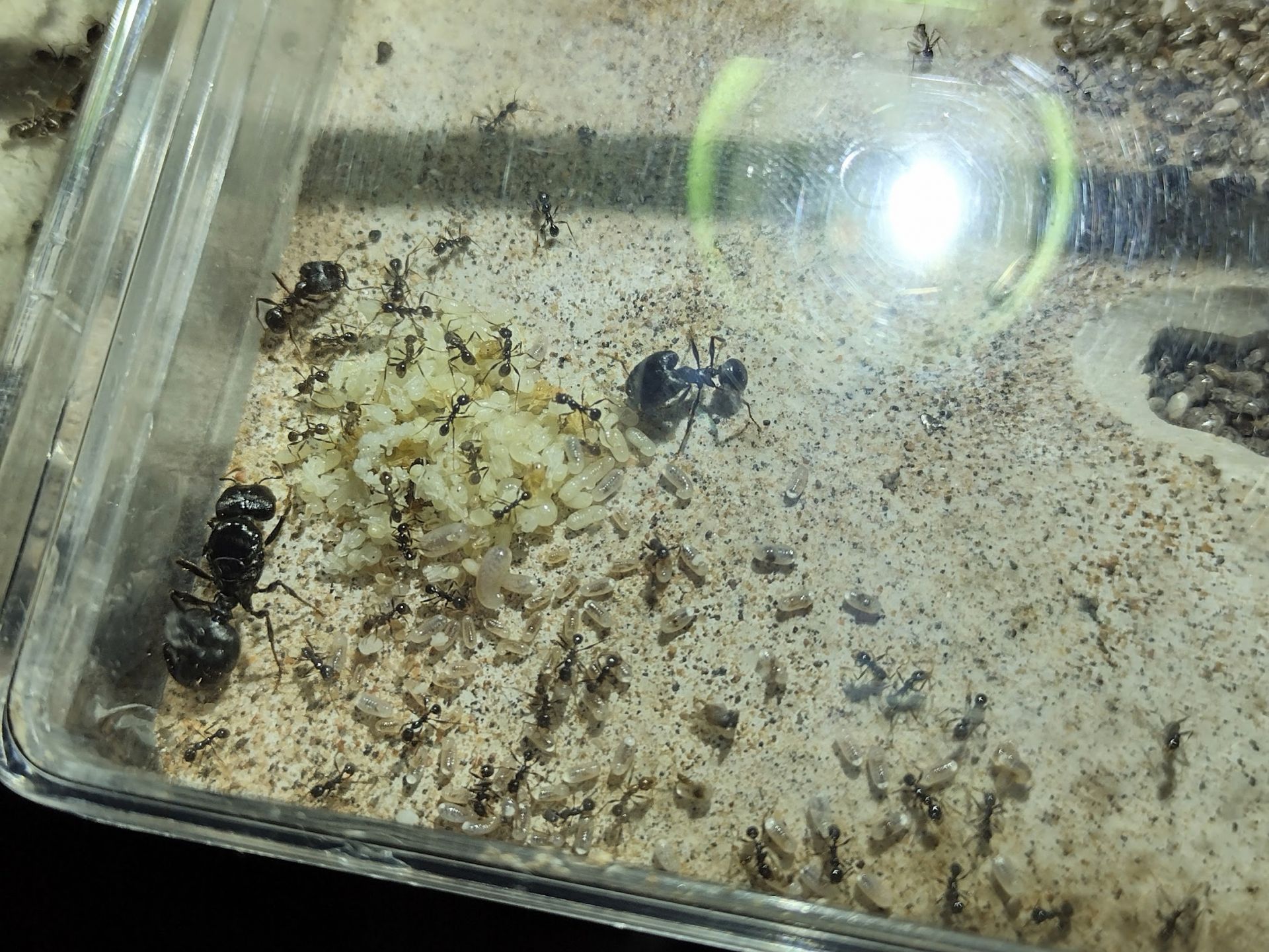
Edited by CheetoLord02, September 7 2021 - 5:36 PM.
- AnthonyP163, SoySauce, Karma and 7 others like this
I like leafcutter ants. Watch The Ultimate Guide to Fungus Growing Ants:
https://youtu.be/VBH...4GkxujxMETFPt8U
This video took like over 100 hours of work, you should for sure watch it.
#46
 Offline
-
Posted September 7 2021 - 5:39 PM
Offline
-
Posted September 7 2021 - 5:39 PM
nice I love the big juicy major larvae ![]()
- m99 likes this
1X Pogonomyrmex occidentalis 40-50 Workers
1X Solenopsis molesta 10 Workers (mono)
Ants I Want: Crematogaster sp, Camponotus Sp., Ponera Pennsylvanica, Mymercocystus sp.
My Youtube channel: https://www.youtube....kUjx-dPFMyVqOLw
Join Our Fledgling Discord Server https://discord.com/...089056687423489
#47
 Offline
-
Posted September 9 2021 - 8:03 AM
Offline
-
Posted September 9 2021 - 8:03 AM
Wow they are super huge! The phedole in Washington in so small
#48
 Offline
-
Posted September 9 2021 - 6:16 PM
Offline
-
Posted September 9 2021 - 6:16 PM

POPULAR
Turns out that major larva from before was just small. It is now a pupa, and will be turning into a pretty disappointing major. This is to be expected though, as even mature colonies tend to produce some pretty dinky majors from time to time.
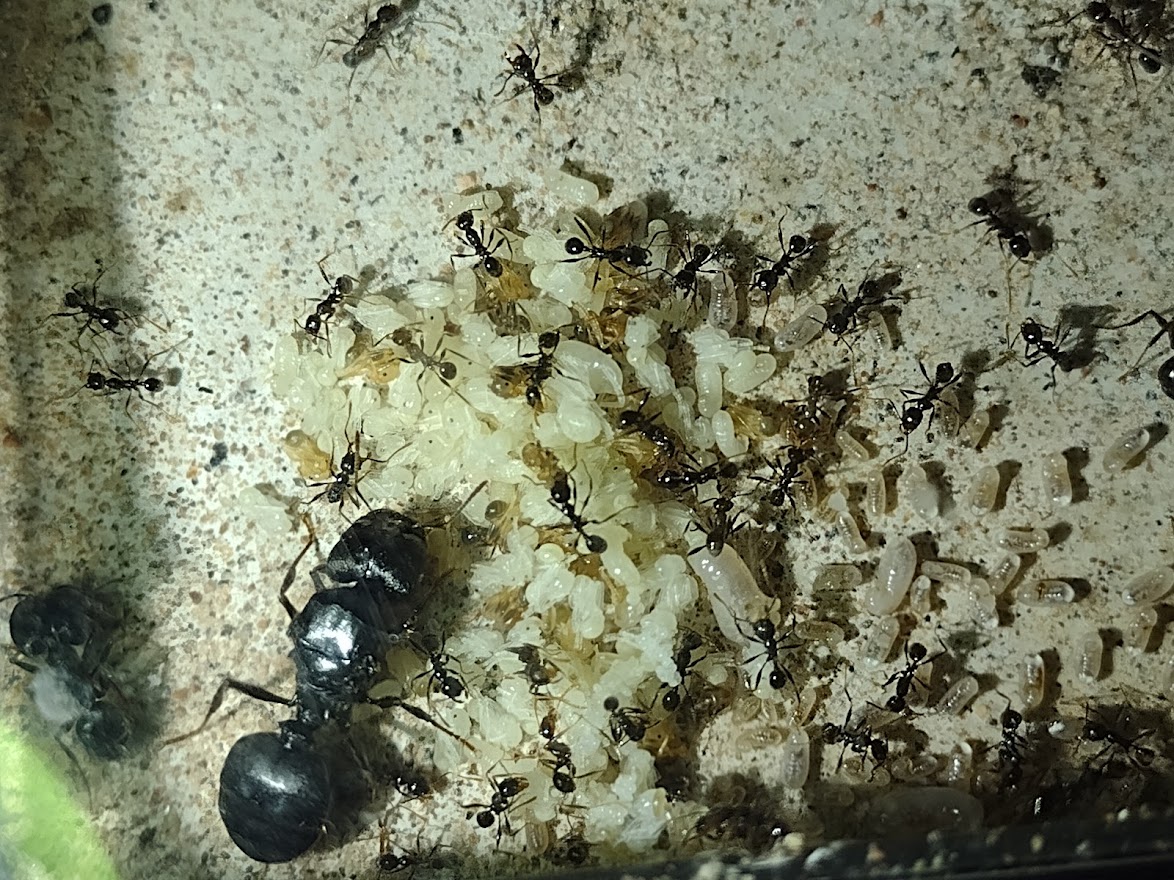
I can now see 4 major brood in total, and two of the larvae are already bigger than the pupa is. Hopefully those two grow to be at least a little bit bigger, that'd be pretty great.
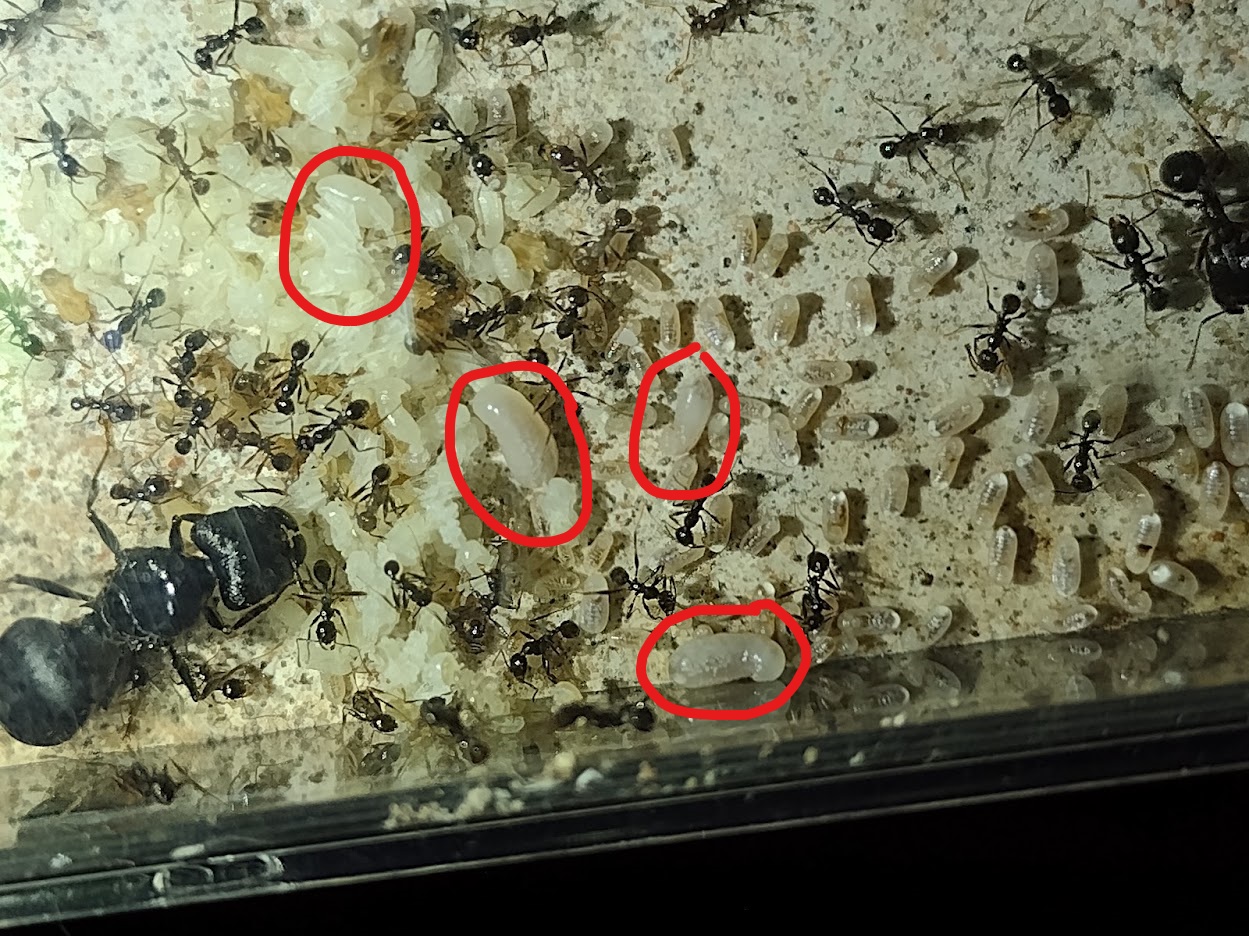
- AnthonyP163, SoySauce, Karma and 10 others like this
I like leafcutter ants. Watch The Ultimate Guide to Fungus Growing Ants:
https://youtu.be/VBH...4GkxujxMETFPt8U
This video took like over 100 hours of work, you should for sure watch it.
#49
 Offline
-
Posted September 10 2021 - 4:27 AM
Offline
-
Posted September 10 2021 - 4:27 AM
You're so lucky, Arizona has all the best ants for the US smh.
I always complain about how Massachusetts only has one Pheidole species which is tiny and rare.
Jealousy overload
- Antkeeper01 likes this
シグナチャーです。예.
#50
 Offline
-
Posted September 10 2021 - 8:31 AM
Offline
-
Posted September 10 2021 - 8:31 AM
You make me want to move to Arizona. You're literally in ant keeper heaven... so lucky.
- SoySauce and Moheab997 like this
My YouTube Channel.
My Ant Store: https://www.missouriantshop.com/
#51
 Offline
-
Posted September 10 2021 - 10:13 AM
Offline
-
Posted September 10 2021 - 10:13 AM

POPULAR
antgallery, on 10 Sept 2021 - 4:31 PM, said:
You make me want to move to Arizona. You're literally in ant keeper heaven... so lucky.
Don't get me wrong, I absolutely love living in Arizona; I can't see myself living anywhere else. But at least for me, it's not easy for me to be getting cool ants. Unfortunately the Phoenix area is pretty terrible for ants, and most good anting spots are 2+ hours away. Eventually I'd like to move to Tucson, as that might just be the best city in the US for ants. Currently though, I've gotta tryhard like crazy to be able to get the cool species that I'm able to get. There was also pretty much no community for AZ antkeepers when I first moved here last year, so I essentially had to discover all of the good anting places and where the most interesting species were at. Thankfully since I moved I've been able to amass an amazing community of AZ keepers, and we've done great work finding good anting spots and techniques and sharing those spots between everyone. Still, it's not like moving to AZ just handed me cool ants on a siver platter; I've had to work my butt off to be able to get the collection that I have today, and that's partially why I love making these journals, so I can share the fruits of my efforts with as many people as possible.
- SoySauce, TennesseeAnts, ANTdrew and 10 others like this
I like leafcutter ants. Watch The Ultimate Guide to Fungus Growing Ants:
https://youtu.be/VBH...4GkxujxMETFPt8U
This video took like over 100 hours of work, you should for sure watch it.
#52
 Offline
-
Posted September 11 2021 - 7:59 AM
Offline
-
Posted September 11 2021 - 7:59 AM
Well, job well done, man. These journals are fantastic. Thanks for posting!
- TennesseeAnts and antgallery like this
#53
 Offline
-
Posted September 11 2021 - 4:33 PM
Offline
-
Posted September 11 2021 - 4:33 PM
I agree well done. I love reading your journals!
My YouTube Channel.
My Ant Store: https://www.missouriantshop.com/
#54
 Offline
-
Posted September 11 2021 - 9:04 PM
Offline
-
Posted September 11 2021 - 9:04 PM
Such a cool species. Can't wait to see them grow even more.
Currently kept species
L. neoniger, P. occidentalis, C. modoc, C. novaeboracensis, C. vicinus, T. immigrans, A. occidentalis, S. molesta, P. imparis, M. kennedyi, M semirufus, F. pacifica, P. californica, M. ergatogyna.
Previously kept species
T. rugatulus, B. depilis.
Looking for
Myrmecocystus pyramicus, Myrmecocystus testaceus
Pheidole creightoni, Pheidole inquilina, Crematogaster coarctata, Crematogaster mutans
#55
 Offline
-
Posted September 12 2021 - 6:08 PM
Offline
-
Posted September 12 2021 - 6:08 PM
The two biggest major larvae grew quite a bit more, and are now pupating. I was honestly hoping that they'd just keep going and end up being supermajors or something, but I think we all knew that wasn't going to happen. Still, they're huge, and will likely end up being 8mm or so when they eclose. I've noticed that while the larvae are developing they're placed next to the main pile, but as soon as they start to pupate they're thrown right back in. It makes it pretty easy to tell when things are still developing, which is pretty nice.
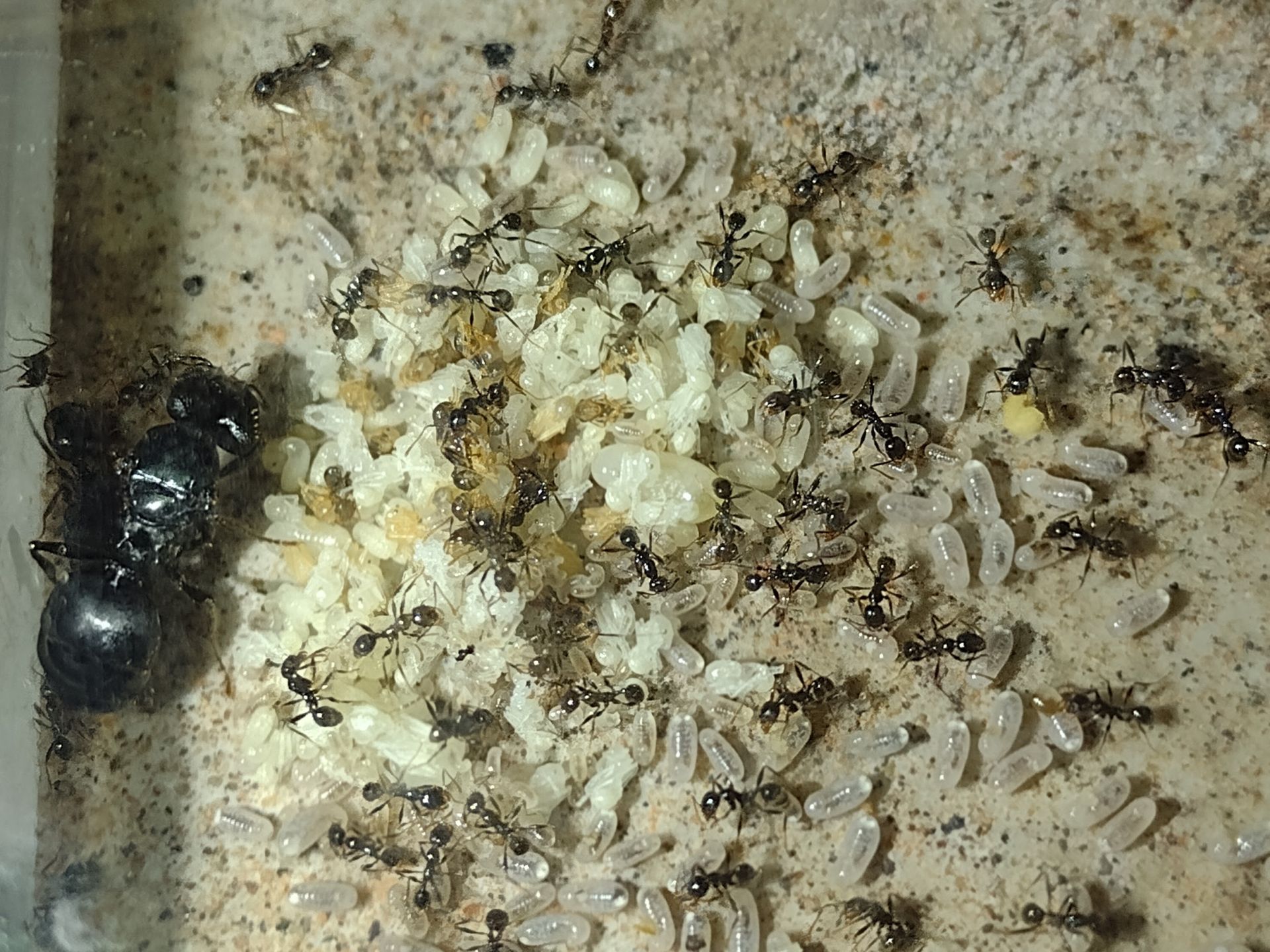
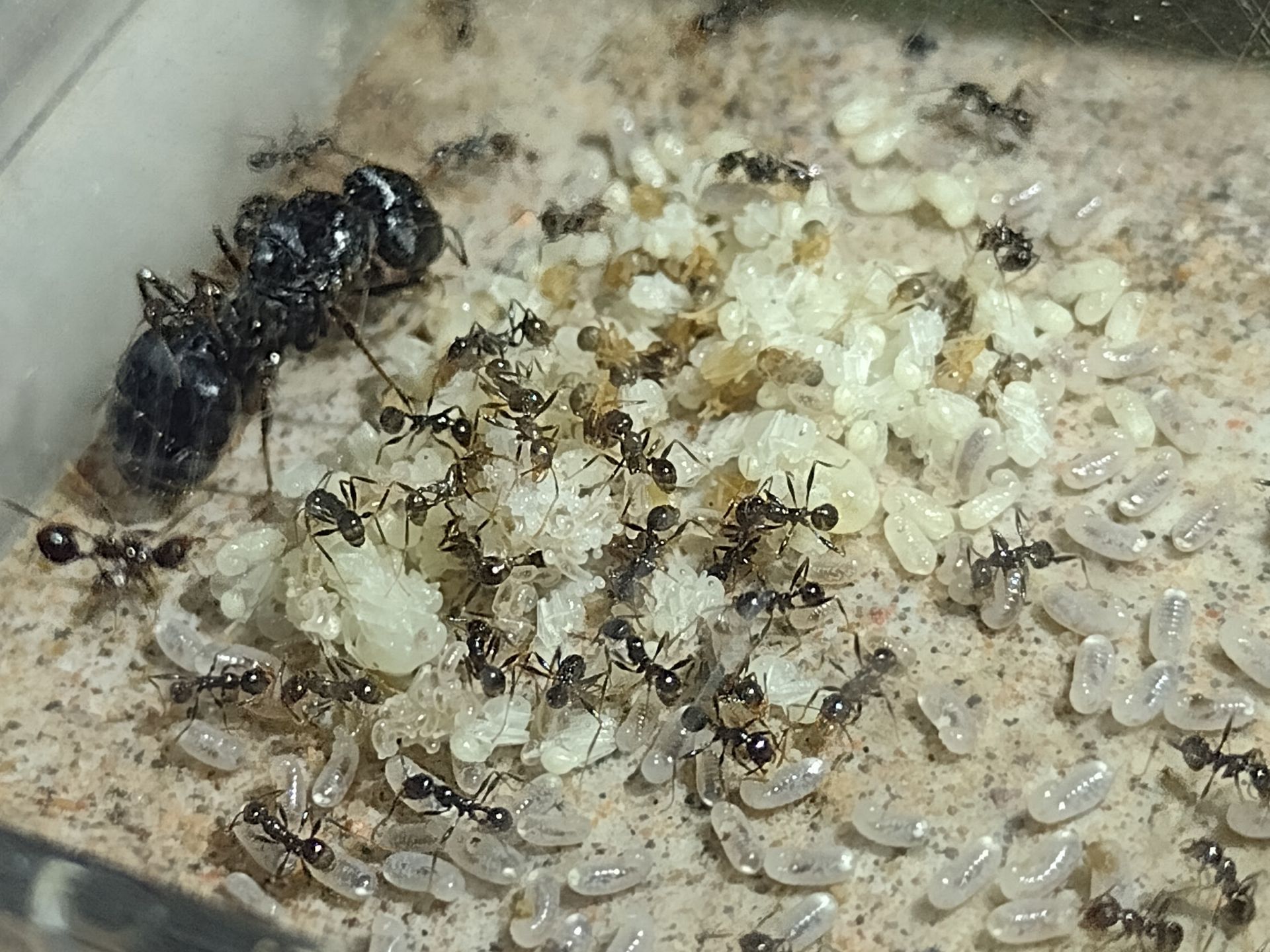
It's now been long enough since their original major larva pupated that I'm keeping an eye out for when it begins to darken. I still think I'm a few days off, but when their overall egg to worker time is so crazy fast I'd imagine sooner than later I'll notice it starting to darken.
I've also been pretty curious about how their growth rate. From the time when all of their boosted brood first finished eclosing on August 3rd, the colony is now pushing 100 workers already in just over 5 weeks. I'm considering their first group of boosted workers to be "nanitics", and so I'm curious. What other species could go from 10 nanitics to 100 workers in 6 weeks? How does this growth compare to say, Solenopsis invicta? I've asked my friends but it's been so long since any of us has kept invicta that we can't really remember. If anybody has any input I'm super curious to hear about everyone here thinks. Do P. rhea grow faster than invicta or not?
- AnthonyP163, Karma, TennesseeAnts and 5 others like this
I like leafcutter ants. Watch The Ultimate Guide to Fungus Growing Ants:
https://youtu.be/VBH...4GkxujxMETFPt8U
This video took like over 100 hours of work, you should for sure watch it.
#56
 Offline
-
Posted September 12 2021 - 6:44 PM
Offline
-
Posted September 12 2021 - 6:44 PM
CheetoLord02, on 13 Sept 2021 - 02:08 AM, said:
The two biggest major larvae grew quite a bit more, and are now pupating. I was honestly hoping that they'd just keep going and end up being supermajors or something, but I think we all knew that wasn't going to happen. Still, they're huge, and will likely end up being 8mm or so when they eclose. I've noticed that while the larvae are developing they're placed next to the main pile, but as soon as they start to pupate they're thrown right back in. It makes it pretty easy to tell when things are still developing, which is pretty nice.
It's now been long enough since their original major larva pupated that I'm keeping an eye out for when it begins to darken. I still think I'm a few days off, but when their overall egg to worker time is so crazy fast I'd imagine sooner than later I'll notice it starting to darken.
I've also been pretty curious about how their growth rate. From the time when all of their boosted brood first finished eclosing on August 3rd, the colony is now pushing 100 workers already in just over 5 weeks. I'm considering their first group of boosted workers to be "nanitics", and so I'm curious. What other species could go from 10 nanitics to 100 workers in 6 weeks? How does this growth compare to say, Solenopsis invicta? I've asked my friends but it's been so long since any of us has kept invicta that we can't really remember. If anybody has any input I'm super curious to hear about everyone here thinks. Do P. rhea grow faster than invicta or not?
Very obviously Carebara diversa, the queen's first batch can have up to 30 workers. Though it does surprise me that P. rhea could have a growth rate similar to C. diversa despite being smaller.
#57
 Offline
-
Posted September 12 2021 - 7:29 PM
Offline
-
Posted September 12 2021 - 7:29 PM
SYUTEO, on 13 Sept 2021 - 02:44 AM, said:
CheetoLord02, on 13 Sept 2021 - 02:08 AM, said:
The two biggest major larvae grew quite a bit more, and are now pupating. I was honestly hoping that they'd just keep going and end up being supermajors or something, but I think we all knew that wasn't going to happen. Still, they're huge, and will likely end up being 8mm or so when they eclose. I've noticed that while the larvae are developing they're placed next to the main pile, but as soon as they start to pupate they're thrown right back in. It makes it pretty easy to tell when things are still developing, which is pretty nice.
It's now been long enough since their original major larva pupated that I'm keeping an eye out for when it begins to darken. I still think I'm a few days off, but when their overall egg to worker time is so crazy fast I'd imagine sooner than later I'll notice it starting to darken.
I've also been pretty curious about how their growth rate. From the time when all of their boosted brood first finished eclosing on August 3rd, the colony is now pushing 100 workers already in just over 5 weeks. I'm considering their first group of boosted workers to be "nanitics", and so I'm curious. What other species could go from 10 nanitics to 100 workers in 6 weeks? How does this growth compare to say, Solenopsis invicta? I've asked my friends but it's been so long since any of us has kept invicta that we can't really remember. If anybody has any input I'm super curious to hear about everyone here thinks. Do P. rhea grow faster than invicta or not?Very obviously Carebara diversa, the queen's first batch can have up to 30 workers. Though it does surprise me that P. rhea could have a growth rate similar to C. diversa despite being smaller.
This is true, even here in the US we have Liometopum apiculatum, which can get over 100 nanitics. However they have a slow egg to worker speed and are likely to get outgrown later.
- TacticalHandleGaming likes this
I like leafcutter ants. Watch The Ultimate Guide to Fungus Growing Ants:
https://youtu.be/VBH...4GkxujxMETFPt8U
This video took like over 100 hours of work, you should for sure watch it.
#58
 Offline
-
Posted September 15 2021 - 10:31 AM
Offline
-
Posted September 15 2021 - 10:31 AM
Lots of news, good news, bad news, all the news.
For good, this colony is going crazy. They have an uncountable number of small larvae that have recently hatched, they're easily over 100 workers now, and they've got at least 5 new major larvae, if not more.
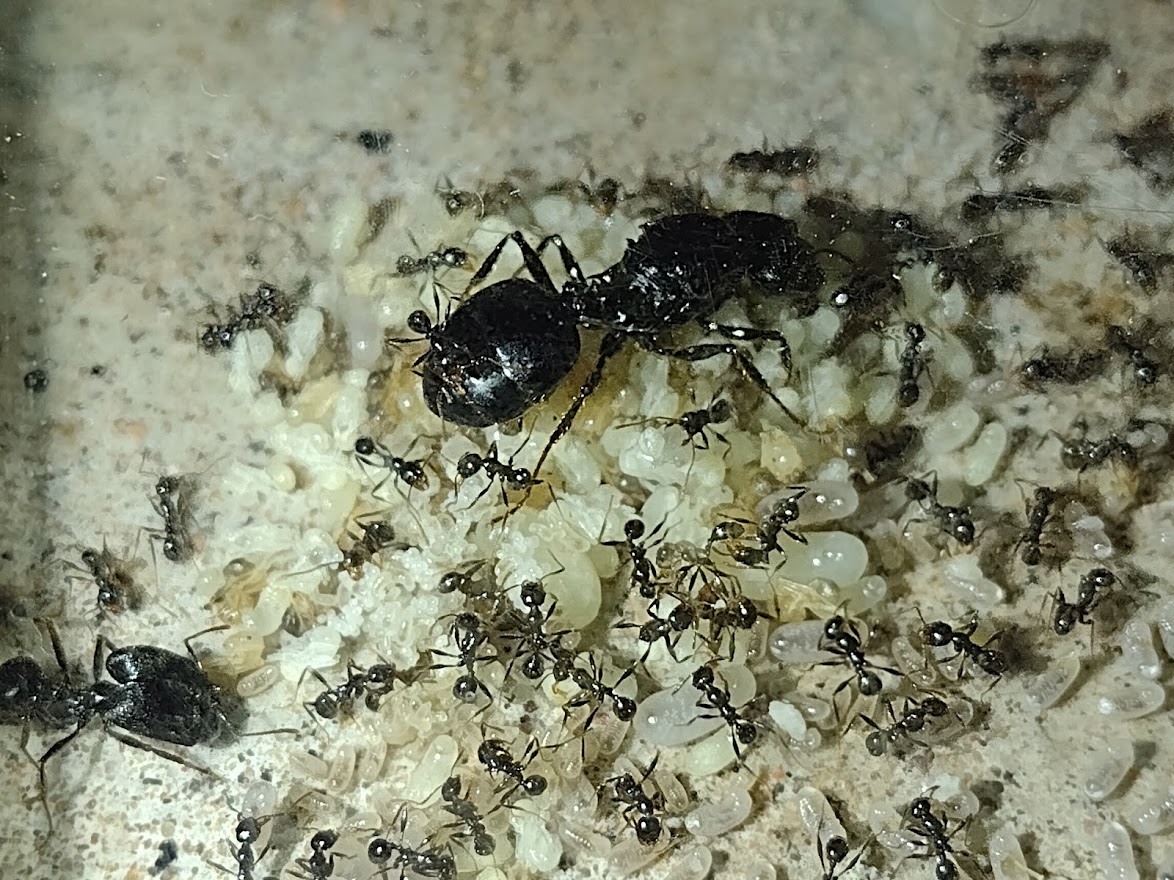
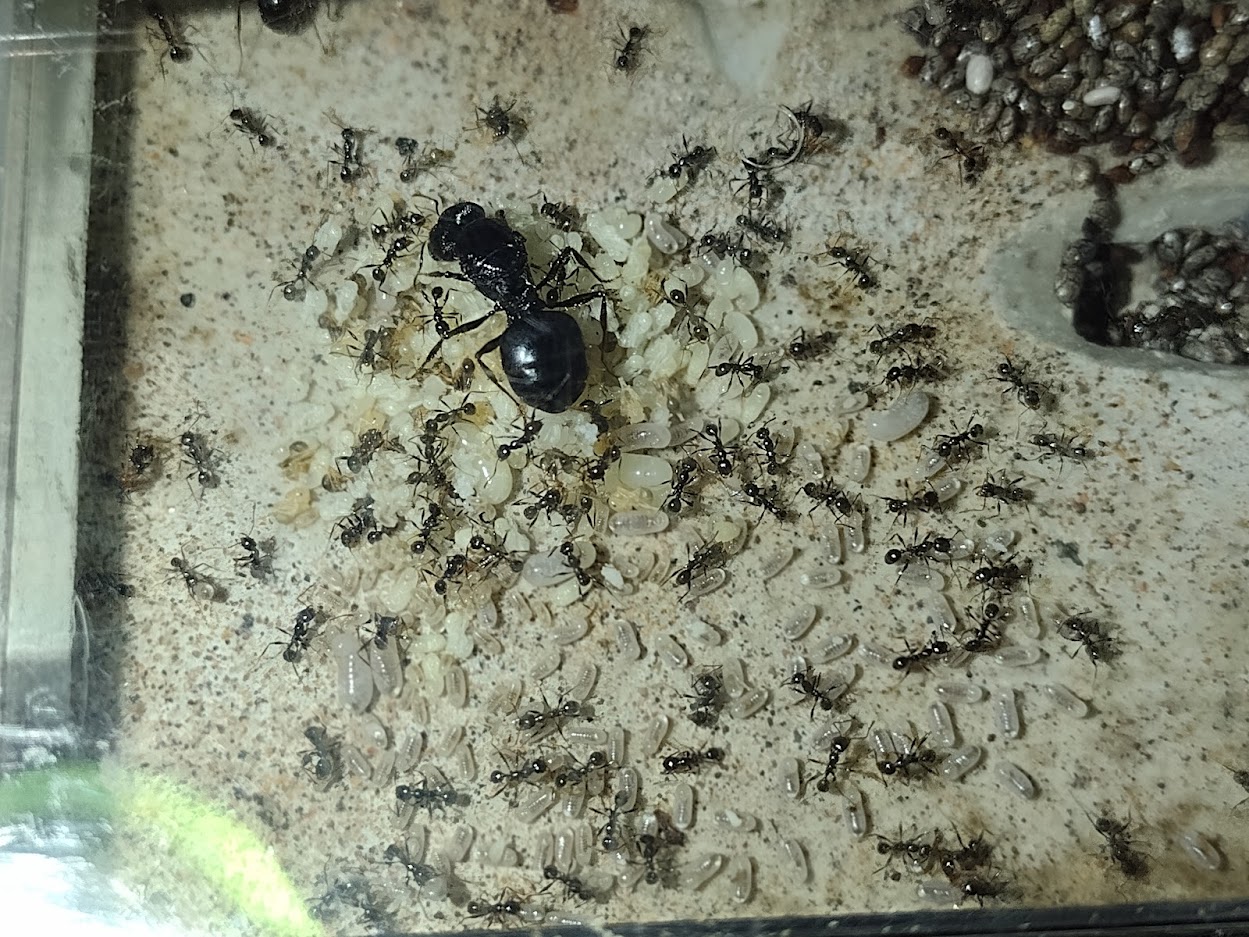
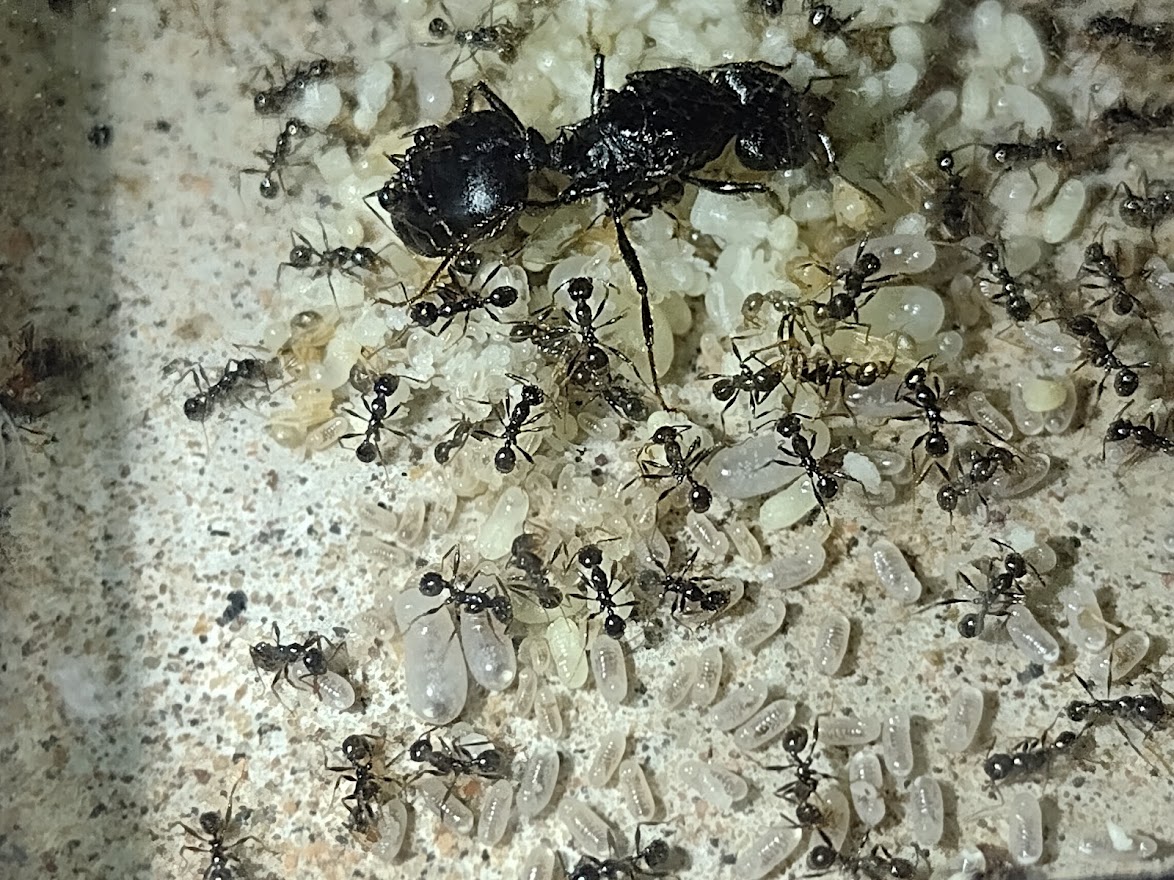
For bad, the smaller major from the brood boost died! I have no idea why, since clearly their lifespan should be longer than 6 weeks or so. Still, with the number of new majors they're producing, I don't think it'll be a huge deal.
For... interesting? They have decided to produce the smallest, wimpiest major I have EVER seen from this species. I originally noticed it as a prepupa, and was originally thinking that it was just a large minor, as the minors that the colony is producing are still at least 1mm smaller than the minors in a mature colony. However... I was wrong.
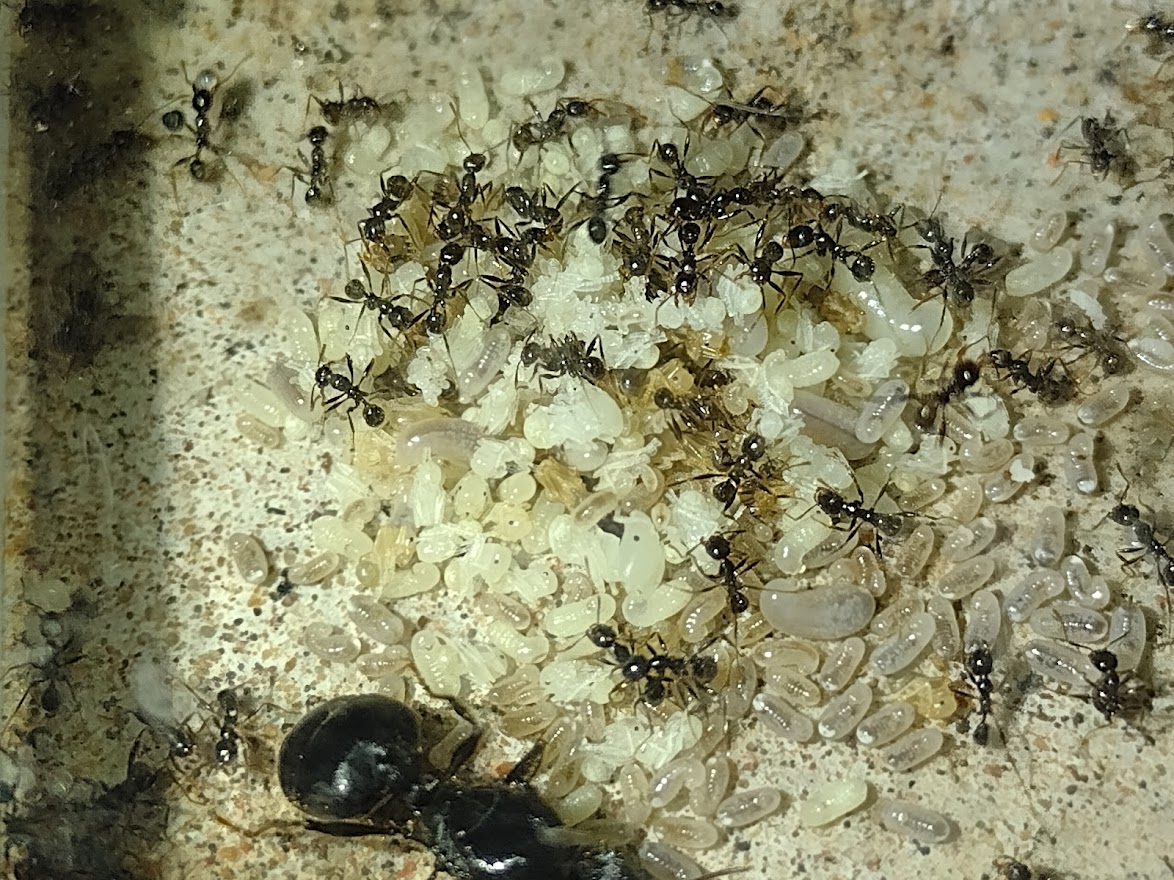
Do you see it? Let me go ahead and circle it.
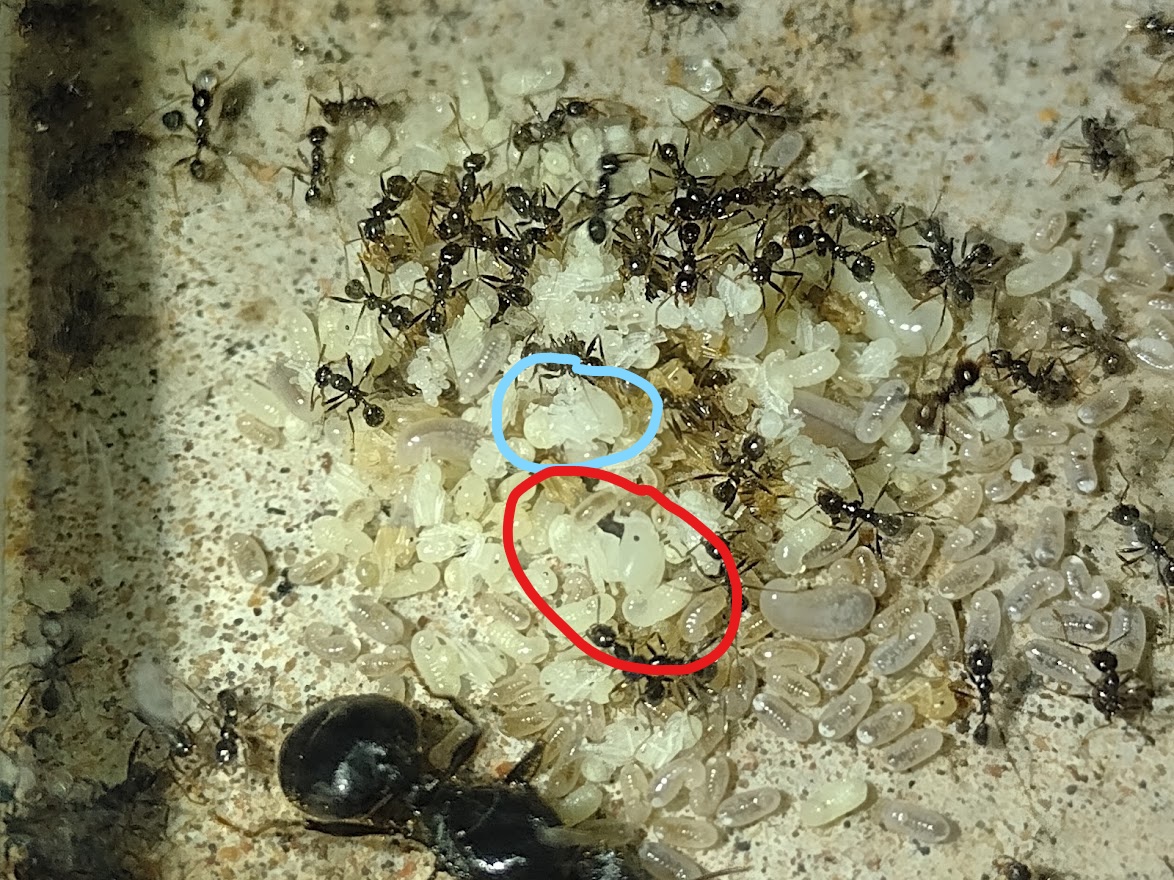
The blue is the new major pupa, where the red circle is their original major, which I had already said was relatively small. It's honestly impressive more than anything, how they're managing to produce a major that's around the size of a P. pilifera major.
- Karma, TennesseeAnts, MinigunL5 and 4 others like this
I like leafcutter ants. Watch The Ultimate Guide to Fungus Growing Ants:
https://youtu.be/VBH...4GkxujxMETFPt8U
This video took like over 100 hours of work, you should for sure watch it.
#59
 Offline
-
Posted September 15 2021 - 11:31 AM
Offline
-
Posted September 15 2021 - 11:31 AM
Ig maybe it’s just because it’s the first she’s producing? Like almost any queens there first majors are pretty small.
#60
 Offline
-
Posted September 15 2021 - 1:37 PM
Offline
-
Posted September 15 2021 - 1:37 PM
and at least its a major!
- Crazycow likes this
1 user(s) are reading this topic
0 members, 1 guests, 0 anonymous users






